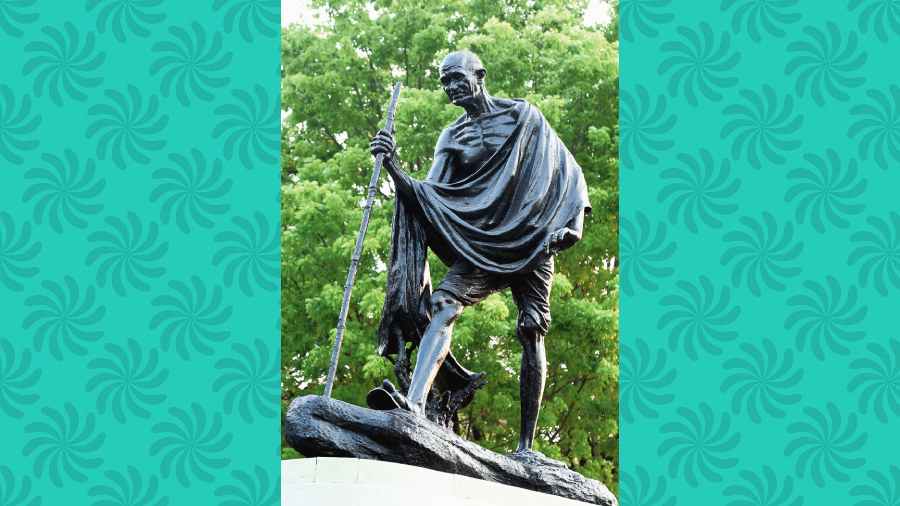Mahatma Gandhi has been without his spectacles since Cyclone Amphan smashed it in May 2020.
If all goes according to plan, his new spectacles should be in place soon.
The Gandhi statue at the Mayo Road-Dufferin Road crossing that has been witness to numerous protests over the years, has borne silently life without the round spectacles.
Devi Prasad Roy Chowdhury had created the bronze statue in 1958 and then Prime Minister Jawaharlal Nehru had inaugurated it.
The state’s public works department has assigned an artisan based in Kalighat’s Patuapara the task of recreating a piece of history.
“It is a bronze statue and the spectacle too would be of the same material. A pair of spectacles has already been carved out of the alloy and has been submitted to the PWD for final approval,” said artisan Pintu Pal, whose family, like most of the neighbourhood he lives in, have been producing clay artefacts and earthen pieces for over a century.
Once approved, the spectacle, which weighs around 2kg and is around 18 inches long from ear to ear, would be fitted to the head of the statue with nuts and bolts to ensure it stays there, Pal said.
Apart from inclement weather, petty thieves who thrive on the sale of stolen metals — scrap or antique — to fulfill their quota of addictions are an additional threat to statues that are carved out of expensive metals and alloys. Bronze, an alloy of copper and tin fetches them a good bargain in the market, police said.
Author Kamal Sarkar has written in his book Kolkatar Statue how the Gandhi statue that we see today on Mayo Road was originally installed at the Park Street-Chowringhee Road crossing as a replacement to an 84-year-old bronze statue of Lt Gen. James Outram. Based on a decision taken by the then chief minister Bidhan Chandra Roy, Gandhi’s statue was installed in place of Lord Outram’s in 1958. The statue was inaugurated by Prime Minister Jawaharlal Nehru on November 30, 1958.
The statue is 11 feet 4 inches tall and is placed on a 13ft high platform carved out of a sandstone rock. The job had reportedly cost the state government Rs 60,000.
The statue was shifted to Mayo Road in 1977 because of work on the Metro Railway project.
Pal, who has been working on the restoration of Gandhi’s spectacles, said he has measured the exact distance between Gandhi’s eyes, the width of his bridge and the ear-to-ear distance for accuracy.
“We took the measurements and then made a dummy model of the spectacle with wire moulded in clay. Once it was approved by PWD officials, I was sanctioned to prepare the bronze spectacles replicating the original round glasses Gandhiji wore,” Pal said.
Pratik Ghosh, director-secretary at the Gandhi Smarak Sangrahalaya in Barrackpore, said Gandhi started wearing glasses only after the Non-Cooperation Movement in 1920. “If you see his pictures from his time in South Africa, he did not have glasses. He started wearing glasses from the time of the Non-Cooperation Movement. But he categorically started wearing the round glasses around a decade later during the Dandi March (Salt March),” Ghosh said. “The round glasses symbolise his simplicity and honesty and his longing for swachhata (cleanliness).”
The Gandhi Smarak Sangrahalaya owns a replica of Gandhi’s round glasses that he was wearing at the time of his demise in 1948. The original pair of spectacles that Gandhi last wore is kept in custody of National Gandhi Museum, New Delhi, said A. Annamalai, its director-secretary.
According to historians, this was not the first time that the Gandhi statue on Mayo Road has undergone some damage and needed a repair. Back in 1958, when the statue was being installed, a few men allegedly attacked it. Of whom five were reportedly arrested. The statue’s right leg was damaged and needed fresh repair before its formal unveiling.
It was reported that there was unrest over installation of a Gandhi statue as a group had demanded Netaji Subhas Chandra Bose’s instead, Sarkar has written in his book.
Roy Choudhury who was running out of time and bronze to repair the injured right leg, had reportedly melted his own father Uma Prasad Roy Chowdhury’s bronze bust named “My Father” to fulfil his commitment to the state government of handing over the statue on time, Sarkar’s book mentions.
More about the statue
• Located at Mayo Road-Dufferin Road crossing
• Built by legendary sculptor Devi Prasad Roy Chowdhury in one-and-a- half years
• Was initially placed at Park Street-Chowringhee Road crossing
• Was inaugurated by the then Prime Minister Jawaharlal Nehru on November 30, 1958
• Was shifted to Mayo Road in 1977 to facilitate Metro Railway work
• Right leg was allegedly damaged by vandals, making it difficult for the statue to stand. Devi Prasad Roy Chowdhury had to melt his own father’s bronze bust for quick supply of bronze to repair the damaged right leg of the statue
More about the glasses

The National Gandhi Museum, New Delhi, showcases the spectacles that Gandhi last wore. Source: National Gandhi Museum, New Delhi
• He started wearing glasses after 1920
• He stuck to the round glasses from 1930 onwards
• The last time he got his eyes tested and ordered a new pair of glasses was on June 2, 1947, less than a year before his death
• His last pair of glasses was made at The Delhi Optical Co. at Chandni Chowk East, Delhi
Sources: National Gandhi Museum, New Delhi, and Kolkatar Statue, a book by Kamal Sarkar
